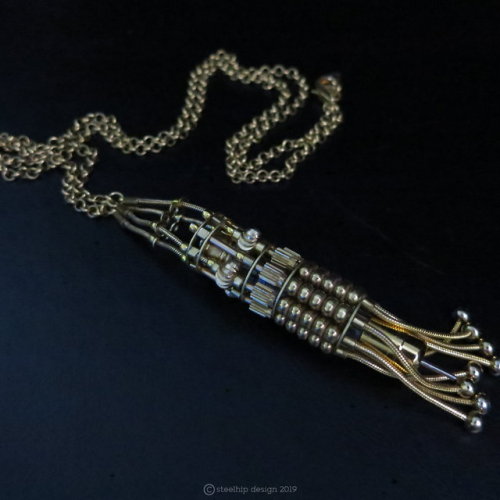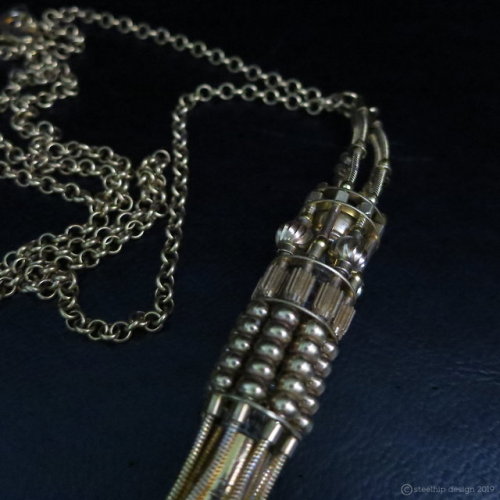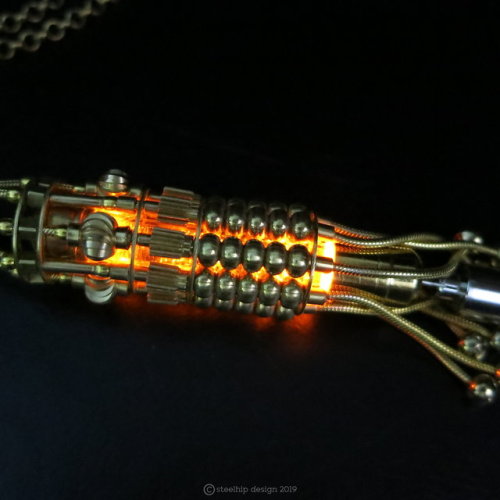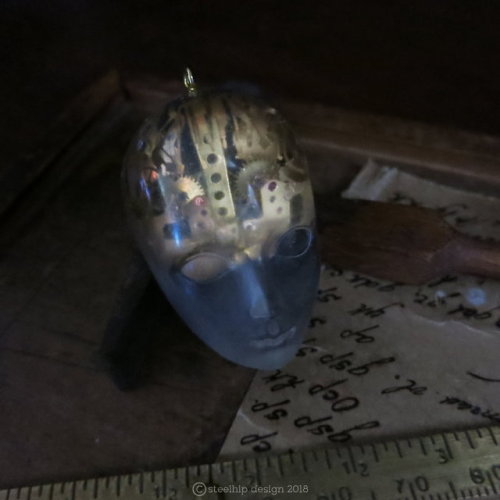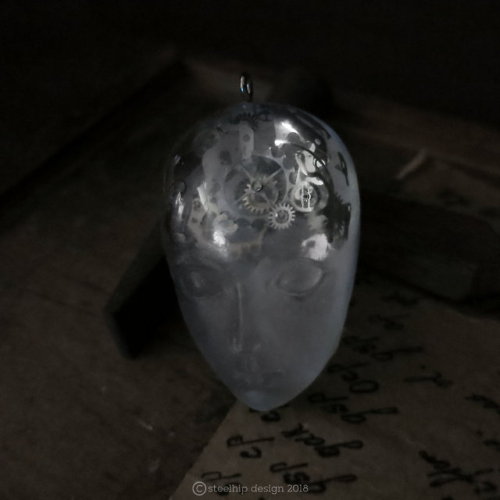#glowing jewelry
The Detector
I’ve been overdosing on documentaries about CERN, the Large Hadron Collider, quantum physics/mechanics and proof of the Higgs Boson. As a science illiterate it fascinates me. That massive tube full of magnets, cameras, detectors and liquid nitrogen is an incredible instrument. Simply awe inspiring. These docos play in the background in my studio and I would occasionally look up to see the massive size and complexity of the machine.
This started with simple flat brass rings with eight holes and some rescued snake chain I cut into eight lengths. This design wasn’t thought out - I just had to wing it. I vaguely wanted a “cage” to hold a glass vial with a Tritium vial in it. Etsy doesn’t like Tritium (their sandpit - their rules) so I sell those pieces off Etsy. It basically glows without the need for a charge - it glows constantly for 10 to 15 years. But I’ve been working with UV resin and recently purchased some tiny LEDS. So I set an orange LED into a gold tone cord cap with UV resin. Then I put a glass tube into the cap and slowly poured resin into the tube stirring it frantically to produce air bubbles. Normally I’m fighting against air bubbles in resin so trying to form and quickly cure them was surprisingly difficult. I didn’t even know if the LED and electronics was going to work after pouring resin on them. The light refracts and diffuses on the bubbles. I was thrilled when it all worked.
Once I had brass beads on the end of each chain length I threaded a range of beads, pinions, tubing and 5 brass rings to stabilize the tube. I still had no idea if the vial would fit through the middle and how I was going to attach it to the structure. This is where the magic often happens - it fit like it was designed with precision. To fasten it within the tube all I had to do was slide another cap on the top of the glass vial and seal it with a screw.
As you can see - when unlit there is a small silver tube, slightly hidden by the brass tassel. To turn the light on - insert that tube into the battery pack - a tiny silver tone tube with a central hole (3/8 x ¼ inch). Once inserted it turns the LED on. Batteries can be replaced easily by unscrewing the cap.
During the day - it’s an unusual mecha deco design - at night with the light - the wow factor.
It sort of looks like a little mechanical cephalopod with those 8 tassel “legs”. I’ve designed this to be worn low on the body - Gatsby length with a long chain. It’s hitched high on the display bust just to show scale and fit it into the photo. If you want it to be higher - I’m happy to alter the chain length.
Post link
These are just a proof of concept. I wanted to include light in my resin heads to highlight layers of mechanical parts. I was partly inspired by the movies Ex Machina and the classic Metropolis. Trying to find an LED small enough was the first problem - the second problem was making the batteries accessible so they could be changed. A few years ago I found LED earrings - the LED is on the pad and the batteries are in the back. They switch on by inserting the post into the back.
These heads all have five layers of mechanical watch parts suspended in resin. It’s a very slow process with each layer needing to cure 24 hours before the next one can be poured. Some of the pieces have symmetrical parts - others are just random parts. The LEDs were set in the last pour leaving the post exposed so it could be inserted into the battery pack.
There are other problems that I still have to address - the original head mold has been taken from a clay form. It has left a rough texture on the head that looks like it’s been scratched all over. I’m happy that the face comes out “frosted” but I have to polish the forehead so the mechanics can be seen. Resin is very soft - so the polishing has to be manual and it takes a long time. Even after hours of polishing it still looks like the piece has been scratched in close up photos. It’s barely noticeable in real life. I’ve come to the realisation that the texture must be sanded down before polishing. It may be a good idea to use a polished form to make my own mold.
They don’t photograph well and the light complicates it. The magnification and refraction of the internal parts is frustrating. I spend a lot of time positioning each piece for symmetry but it looks like a mess in the photos. If I can’t take great photos - they can’t be sold online. But it’s early days in this artistic tangent. I initially bought the molds to make a head for a static miniature reproduction of a Hugo like automata. Unfortunately they are too big for that purpose.
Post link

